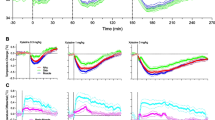Abstract
The ipsilateral intrastriatal administration of the specific adenosine A2a receptor agonist, 2-[p-(2-carboxyethyl)phenethylamino]-5′-N-ethylcarboxamido adenosine (CGS 21680), produced a dose related decrease in apomorphine-induced rotation in the unilaterally 6-hydroxydopamine-lesioned rat. This effect could be reversed by intrastriatal infusions of the A2a antagonist, 4-amino-l-phenyl[1,2,4]triazolo[4,3-a]quinoxaline (CP 66,713). However, CP 66,713 had no significant effect when infused alone, neither did it influence the response to apomorphine in the absence of CGS 21680. The possible behavioural interactions between A2a receptors and striatal ACh activity were also investigated using this model. Atropine administered intrastriatally in a dose that had no effect on the response to apomorphine reduced the inhibitory effects of CGS 21680 on apomorphine-induced turning. Naloxone also reduced the effects of apomorphine, an effect which could be prevented by the co-administration of atropine, or CP 66,713. These results indicate that adenosine agonists can modulate apomorphine-induced turning by an interaction with both cholinergic and opioidergic mechanisms in the striatum.
Similar content being viewed by others
References
Alexander SP, Reddington M (1989) The cellular localization of adenosine receptors in rat neostriatum. Neuroscience 28:645–651
Brown SJ, James S, Reddington M, Richardson PJ (1990) Both A1 and A2a purine receptors regulate striatal acetylcholine release. J Neurochem 55:31–38
Brown SJ, Gill R, Evenden JL, Iversen SD (1991) Striatal A2 receptor regulates apomorphine-induced turning in rats with unilateral dopamine denervation. Psychopharmacology 103:78–82
Consolo L, Ladinski H, Bianchi S (1975) Decrease in rat striatal acetylcholine levels by some direct and indirect acting dopaminergic antagonists. Eur J Pharmacol 33:345–351
Daly JW (1985) Adenosine receptors. Adv Cyc Nucl Pro Phos Res 19:29–46
De Belleroche J, Neal MJ (1982) The contrasting effects of neuroleptics on transmitter release from the nucleus accumbens and corpus striatum. Neuropharmacology 21:529–537
Ferre S, Von Euler V, Johansson B, Fredholm BB, Fuxe K (1991) Stimulation of high-affinity adenosine-A2 receptors decreases the affinity of dopamine D2 receptors in rat striatal membranes. Proc Natl Acad Sci USA 88:7238–7241
Fink JS, Weaver DR, Rivkees SA, Peterfreund RA, Pollack A, Adler EM, Reppert SM (1992) Molecular cloning of the rat A2 adenosine receptor: selective co-expression with D2 dopamine receptors in rat striatum. Mol Brain Res 14:186–195
Fredholm BB (1982) Adenosine receptors. Med Biol 60:289–293
Fuxe K, Ungerstedt U (1974) Action of caffeine on supersensitive dopamine receptors: considerable enhancement of receptor response to treatment with DOPA and dopamine agonists. Med Biol 52:48–54
Green RD, Proudfit HK, Yeung S-MH (1982) Modulation of striatal dopaminergic function by local injection of 5′-N-ethylcarboxamido adenosine. Science 218:58–60
Grima B, Lamoroux A, Blanot F, Biguet N, Mallet J (1985) Complete coding sequence of rat tyrosine hydroxylase mRNA. Proc Natl Acad Sci USA 82:617–621
Harms HH, Wardeh G, Mulder AH (1979) Effect of adenosine depolarization-induced release of various radiolabelled transmitters from slices of rat corpus striatum. Neuropharmacology 18:577–580
Herrera-Marschitz M, Casas M, Ungerstedt U (1988) Caffeine produces contralateral rotation in rats with unilateral dopamine denervation: comparisons with apomorphine-induced responses. Psychopharmacology 94:38–45
Herting G, Zumstein A, Jackish R, Hoffmann I, Stark K (1980) Modulation by endogenous dopamine of the release of acetylcholine in the caudate nucleus of the rabbit. Naunyn-Schmiedeberg's Arch Pharmacol 315:111–117
James S, Xuereb JH, Askalan R, Richardson PJ (1992) Adenosine receptors in post-mortem human brain. Br J Pharmacol 105:238–244
Jarvis MF (1988) Autoradiographic localization and characterization of brain adenosine receptor subtypes. In: Leslie F, Altar CA (eds) Receptor localization: ligand autoradiography. Liss, New York, pp 95–113
Jarvis MF, Williams N (1989) Direct autoradiographic localization of adenosine A2 receptors in the rat brain using the A2 selective agonist3H-CGS 21680. Eur J Pharmacol 168:243–246
Josselyn SA, Beninger RJ (1991) Behavioural effects of intrastriatal caffeine mediated by adenosinergic modulation of dopamine. Biochem Behav 39:97–103
Kaakkola S (1981) Effect of nicotinic and muscarinic drugs on amphetamine and apomorphine-induced circling behaviour in rats. Acta Pharmacol Toxicol 48:162–167
Kelly PH, Miller RJ (1975) The interaction of neuroleptic and muscarinic agents with central dopaminergic systems. Br J Pharmacol 54:115–121
Michaelis L, Michaelis EK, Myers SL (1979) Adenosine modulation of synaptosomal dopamine release. Life Sci 24:2083–2092
Miller R, Beninger RJ (1991) On the interpretation of asymmetries of posture and locomotion produced with dopamine agonists in animals with unilateral depletion of striatal dopamine. Prog Neurobiol 36:229–256
Pollack AE, Wooten GF (1992) D2 dopaminergic regulation of striatal proenkephalin mRNA levels is mediated at least in part through cholinergic interneurones. Mol Brain Res 13:35–41
Sandor NT, Kiss J, Sandor A, Lendvai B, Vizi ES (1991) Naloxone enhances the release of acetylcholine from cholinergic interneurones of the striatum if dopaminergic input is impaired. Brain Res 552:343–345
Sarges R, Howard HR, Browne RG, Lebel CA, Seymour PA, Kae BK (1990) 4-amino[1,2,4]triazolo[4,3-a]quinoxalines. A novel class of potent adenosine receptor antagonists and potential rapid onset antidepressants. J Med Chem 33:2240–2254
Schiffmann SN, Jacobs O, Vanderhaeghen J-J (1991) Striatal restricted adenosine A2 receptor (RDC8) is expressed by enkephalin but not by substance P neurons: an in situ hybridization histochemistry study. J Neurochem 57:1062–1067
Sirinathsinghji DJS, Morris BJ, Wisden W, Northrop A, Hunt SP, Dunnett SB (1990) Gene expression in striatal grafts 1. Cellular localization of neurotransmitter mRNAs. Neuroscience 34:657–686
Stoof J, Kebabian J (1981) Opposing roles for D1 and D2 dopamine receptors in efflux of cyclic-AMP from rat neostriatum. Nature 294:366–368
Ungerstedt U (1971) Post-synaptic supersensitivity after 6-hydroxy-dopamine degeneration of the nigrostriatal dopamine system. Acta Physiol Scand Suppl 367:69–93
Ungerstedt U, Arbuthnott G (1970) Quantitative recording of rotational behaviour in rats after 6-hydroxydopamine lesions of the nigrostriatal dopamine system. Brain Res 24:485–493
Van Calker D, Muller M, Hamprecht B (1979) Adenosine regulates via two different types of receptors, the accumulation of cyclic AMP in cultured brain cells. J Neurochem 33:999–1005
Author information
Authors and Affiliations
Rights and permissions
About this article
Cite this article
Vellucci, S.V., Sirinathsinghji, D.J.S. & Richardson, P.J. Adenosine A2 receptor regulation of apomorphine-induced turning in rats with unilateral striatal dopamine denervation. Psychopharmacology 111, 383–388 (1993). https://doi.org/10.1007/BF02244956
Received:
Revised:
Issue Date:
DOI: https://doi.org/10.1007/BF02244956




